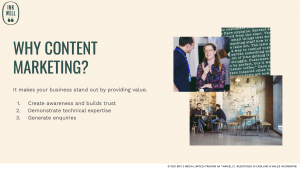Chris Goodfellow (Founder of Inkwell) shared his top tips on developing a content marketing strategy for the latest Smart Cookies Breakfast Club.
Content marketing creates conversations and helps build communities. It plays a crucial step in today’s sales funnel.
In this Smart Cookies session, Inkwell founder Chris shares his tips on developing a content marketing strategy, from brainstorming ideas and planning different types of content to marketing and SEO.
He gives practical examples of campaigns that you can learn from and shares tips that you can implement straight away to get better results from the effort you invest in content marketing.
You can watch the replay below or read on for a write-up…

Why content marketing?
Why is content marketing important? What value does it provide for your business?

Content marketing:
- Drives awareness and build trust. It drives people to your website and is the start to them building a relationship with you
- Gives you an opportunity to demonstrate technical expertise. When we are shopping around for a product or service, we want to feel that the company selling to us really knows their stuff. Content marketing provides an amazing opportunity to do that.
- Generates enquiries. It’s always worth bringing everything back to what your overall marketing and sales goals are, how content marketing can help people enter the funnel and move them forward to enquire about your business.
So, where do you start?
Start with your customers.
As with any sales process, it’s important to start with your audience. When you speak to a new prospect you want to figure out exactly what their challenges are, what they need, and how you can help.

When we think about ideation and what we want to write about, we talk to customers. We do discovery polls, we go to meetups, whatever it takes to figure out the ideas. You’re looking to identify challenges you can help them with that are related to your business.
When you’re looking for ideas, there are a few ways to do that. There are a few ways to have that audience-centric, audience-led, content marketing strategy.
1. Talk to your clients
The first (most obvious) one is to talk to clients. You’re already doing this all the time – whether it’s in a shop, whether it’s in a sales meeting, whether it’s on the customer’s phone line. It’s really interesting to make a note of the stuff that keeps coming up.
When you meet somebody at a conference, what are the things that people are really excited about in your space? What kind of expertise do they want from you? What comes up in conversation? If you see that happen two or three times, that’s a really good indicator that could make part or piece of content, because if the person that you’re speaking to is really excited and interested about it, chances are lots of other people in that customer group are too.
2. Map customer journeys.
We’re not talking about e-commerce type "where do they click?" customer journeys, but the purpose of your company. Usually, a business’ wider goal is to move a person from point A to point B. If you’re a fitness instructor, you might want to get somebody that’s unhealthy and unhappy about that to somebody that has a sustainable fitness routine and feels good about themselves.
Even if you have a product with individual use point, you’re probably thinking about a wider purpose and impact. Mapping that customer evolution, that customer journey, helps you start to pick out points where you can help solve challenges and create some really interesting content.
Inkwell does this by sitting down with businesses with an A3 piece of paper and going through their journey. From when they launched their business to their third year, or their first round of investment, or whatever important milestones and challenges have come up along the way. That’s one really good way to prompt people to come up with ideas.
3. Look at your data
If you have Google Analytics or other data from your marketing channels you’ll have all sorts of information about how people buy things, how they come to and leave your website – all sorts of stuff! There’s always opportunities to analyse this to figure out what people are interested in and why.

Different types of content.
Once you’ve brainstormed your topic ideas, it’s time to think about how to put them into strategy. It’s important to think about the different types of content that you can leverage: podcasts, infographics, blog posts (long and short-form), downloadable PDFs, videos, animations. The list goes on!
You need to think about what makes sense to your audience. You might have hit upon an idea that’s really in-depth and worth a 3000-word downloadable guide that justifies you getting someone’s email address. Could another topic work better as a one-minute video, or series of videos? You’ve got to think about how your ideas can best be conveyed and the easiest way to help your reader.
Then, you can think about different ways to leverage that content. You’ve put a lot of time and effort into creating something, there may be a few other ways you can use it.
For example, this post! This was initially delivered as a live webinar, but now we’ve popped the recording on YouTube and this write up on our blog. We’ll create shorter promo videos out of it for social media.
It’s important that you don’t get overwhelmed by the sheer number of different content types you can utilise. Focus your efforts on two or three types and do them well, rather than spreading yourself too thinly.
Content pillars
Imagine coming away from your client interviews with lots of different ideas and topics to write about. At this point, it’s helpful to try and organise them into a few buckets or pillars – themes that your content strategy is going to be based around.
For example, a software company like CookiesHQ will have one bucket that’s very much about the technical stuff and nifty things we’ve done for clients, or discovered in our work. This is about demonstrating our expertise and giving a sense of what it’s like to work with us. These have a very specific role and persona attached.
Another one might be something like diversity in tech, or coding for kids – important topics related to our industry. This would be top of the funnel stuff – building brand awareness and making an impact.
So, you can see how you might pick three or four pillars over a six or 12-month period. This is to ensure that your team knows exactly what that type of content is, what it’s supposed to do for the company and to give your content strategy and all the ideas you have a bit more structure.

Tone of voice.
There’s an almost bewildering amount of choice when it comes to content around a subject. So, you really need to writre in a way that’s dynamic. That cuts through the noise and can represent your brand in the best way.
Tone of voice guidelines should be a part of your brand guidelines. It doesn’t have to be a huge exercise, but it should span every written word across the business. They should dictate or help your team understand how to write everything – from sales emails to blog posts to copy in the product itself.
Some things to remember to improve your writing straight away:
- Make sure you have a clear structure in your copy. Use subheadings to make it really easy for your user to understand and use the content.
- Short sentences are your friend! Try to keep things simple and have one thought per sentence. It makes things much easier to read.
- Use conversational language. Not necessarily how you would talk when you’ve had a few pints at the pub, but in a business setting. When you’re speaking up in a meeting or at a conference you’ll likely have a conversational tone. Try and bring this out in your writing.
Your tone of voice will also help when it comes to jargon. If there are industry terms that are used commonly and that everybody reading your article will understand, it’s a nice way to show that you understand your audience and build familiarity with them.
Having a consistent tone of voice also helps build trust with your audience. When we’re moving around and examining a brand, jumping on their social media, their blog, looking at their product pages, our subconscious needs the sound, look and feel of content to be consistent. That goes for all of your marketing – from the colour palette to the tone of voice, to how your customer service staff talk to customers.
Content marketing and SEO
Chris uses The Pitch as an example to take a look at SEO. Traffic to The Pitch from organic search has a 01:04 session duration. Referrals is nearly two minutes. It’s really important to think about how readers are discovering your content, how it should be presented and where their attention is.
It’s likely that a lot of your traffic is coming from search, so you have to be aware that users looking for a very specific search query. They’re looking for an answer to a very specific question. And they might not know your brand. So just keep that in mind when you’re creating content marketing.
SEO starts with the reader. No one outside of Google knows how the algorithm works (and there’s probably not one person in Google who knows either). We’re talking about over 200 ranking factors.
What we do know is best practice, and the shortcut for getting the best practice right is to start with your reader.
On-page layout
If you get the right layout and you make it clear and easy to understand, Google will love that. You’ve got to break articles up into useful headings. Title heading is H1, and then it’s H2. H3, and so on. Google understands that hierarchy of information.
Not only is it really great for your reader – because they understand this is the main thrust of the article, this is a subheading, and they can scan down that and see what’s valuable for them – but it helps Google understand the hierarchy of information too, and therefore the search will look upon your page favourably.
Keywords
Include keywords. Once you’ve identified your topic and know the keywords that go with it use them in natural language. You don’t want to force it (and do what they call ‘keyword stuffing’). You just want to do the housekeeping of making sure the keywords that you have identified appear in the places that Google wants to see them. So your primary keyword has got to be in the headline. It’s got to be in your lead paragraph, it’s got to be in some of your subheadings, and then a couple of times in your copy too. So make sure you’ve got your keywords in mind, but write naturally and just do the housekeeping.
Internal and external linking
Then finally, make sure you get those external and internal links in. They really help Google understand how your site’s laid out and they’re also really useful from a user perspective as well. You want them to be able to click through to another article or resource you have that’s going to help them. It’s a win-win!
A big thank you to Chris for such a great session – you can find out more about what he’s up to by following Inkwell on Twitter or connecting with him on LinkedIn
Why not join us at our next Smart Cookies Breakfast Club session? Bitesize chunks of top quality content to help you take your business to the next level, all before 9 am!